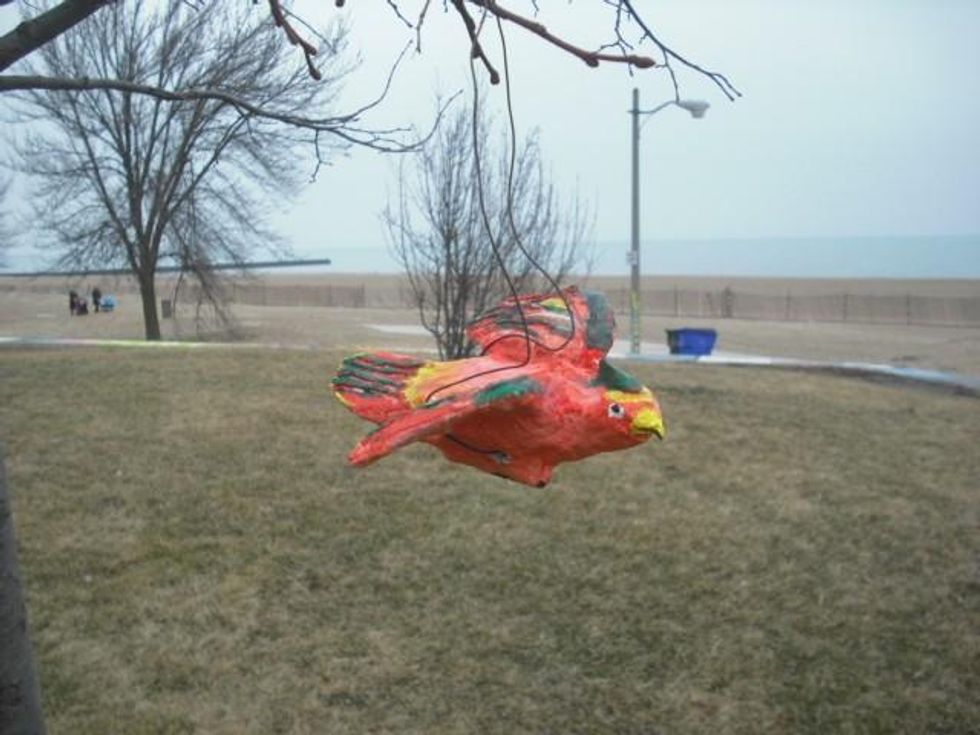My daughter went jogging to the lake. When she came back, she reported: "Dad, someone hung a bird in the Barbara tree."
When I went out to investigate, sure enough, it was still there, a brightly painted, reddish-orange papier-mache bird, daggling on a wire from a low branch.
I live in the far north corner of Chicago, half a mile from Lake Michigan. Some years ago, I donated money to the Chicago Park District and they planted a tree of my choosing (a linden) in honor of my late wife. This is the Barbara tree, which I visit regularly. It has no plaque announcing its name or status; it's just a tree, barely more than a sapling, standing on a tiny rise in Loyola Park, overlooking the lake. About 12 feet away stands the Fred tree, a silver maple, planted in honor of my sister's late husband, who died a year and a half after Barbara did. Both died of cancer.
I haven't written about these deaths, or the nature of grief, in a long time. Life goes on, unfolding unpredictably every day. My long-ago sense of irreplaceable loss has been given over, in many ways, to the tree, to life, to my grown-up kid, to the column I write and to a wary optimism that love is shaping the future despite so many reports to the contrary.
I'm appalled by these reports - of economic fissure, the rise of the corporatocracy, the collapse of social services, the rape of the commons, the insane drumbeat for another war - but insist in this moment on celebrating the infinitesimal positive.
I have no idea who hung a bird on the Barbara tree. Hardly anyone knows about the tree. I surmise it was a stranger because a friend would have told me; and if it was a stranger, the Barbara tree was decorated at random, without awareness that it stands as a memorial to a mom and passionate public-interest attorney who died, at age 50, in 1998. That this is probably the case delights me beyond all reason.
Maybe much of my delight is due to the fact that I'm working with some friends on a project that celebrates participatory consciousness and the giving economy - that pushes against the grinding alienation of our times. We're developing a blog called Chicago Spirit, and we're hoping that lots of people will want to contribute writing, art and perhaps things we do not yet imagine to it. Maybe even papier-mache birds.
This is the mission statement:
"Never has a time been more ripe or urgent for ordinary citizens to step up in the fullness of their humanity and not simply demand but create change in how society functions and how we live our lives.
"Chicago Spirit seeks to celebrate and further the powerful creative and healing forces emerging in our city: in politics, the arts, education, the environment, law enforcement and all other ways. In so doing, we seek to collaborate in uniting these local efforts with the great awakening nationally and globally. We declare this awakening to be the dawn of a vibrant, unprecedented global peace."
Two weeks ago I wrote about being part of a Men's Art Forum retreat in which a man found liberation from the ghosts of his past in a drawing exercise. It was an example of what we have dubbed, at Chicago Spirit, "art beyond ego": art that aligns with the primal urge to create; art whose purpose is to heal, not merely to distract (i.e., "entertain").
Chicago Spirit seeks to expand the idea of creative healing to every facet of our lives. Last week I wrote about a program of restorative practices in place at Baltimore's City Springs School - a philosophy of teaching, keeping order and creating community that involves everyone as a full, equal participant. This is far from a simple idea. One skeptical reader at Huffington Post posted this remarkable comment:
"Nice sentiment but far from possible. Consider the following scenario: You are a high school teacher and teach upwards of 140 students a day, most of whom are 'troubled.' You lead special lessons about Maslow's hierarchy of needs. You spend time sitting next to students, making eye contact, asking them 'What is wrong?' and 'How can I help you?' You hold your students to high standards and explain why it is important. You build a community around dialogues and reflections AND teach a foreign language worthy of high school credit.
"Now add 5-10 interruptions per class period, no disciplinary support if there is a fight, unsafe hallway outside your room, and students who are: hungry, abused, sick, high, work the night shift, live with an older sibling, take 3 city busses to come to school, who see nothing wrong with stealing, lying, cheating, cursing, or fighting after being 'dissed' and who only listen to you in-between tweets. In addition, redo this whole scenario on a trimester schedule with two more sets of 140 students to begin the whole process over again. Oh, and by the way, the average amount of absences from school is: 20 for the first trimester. Do you understand my skepticism?"
How do we proceed in the face of impossible odds? I seek not to falsely minimize those odds or belittle the writer's skepticism. I seek to honor both and still celebrate the possible future, the one where, among so much else, the efforts of heroic teachers aren't lost in dying (or murdered) school systems.
And against all odds I'm imagining a mysterious red-orange papier-mache bird as a harbinger of that future.

